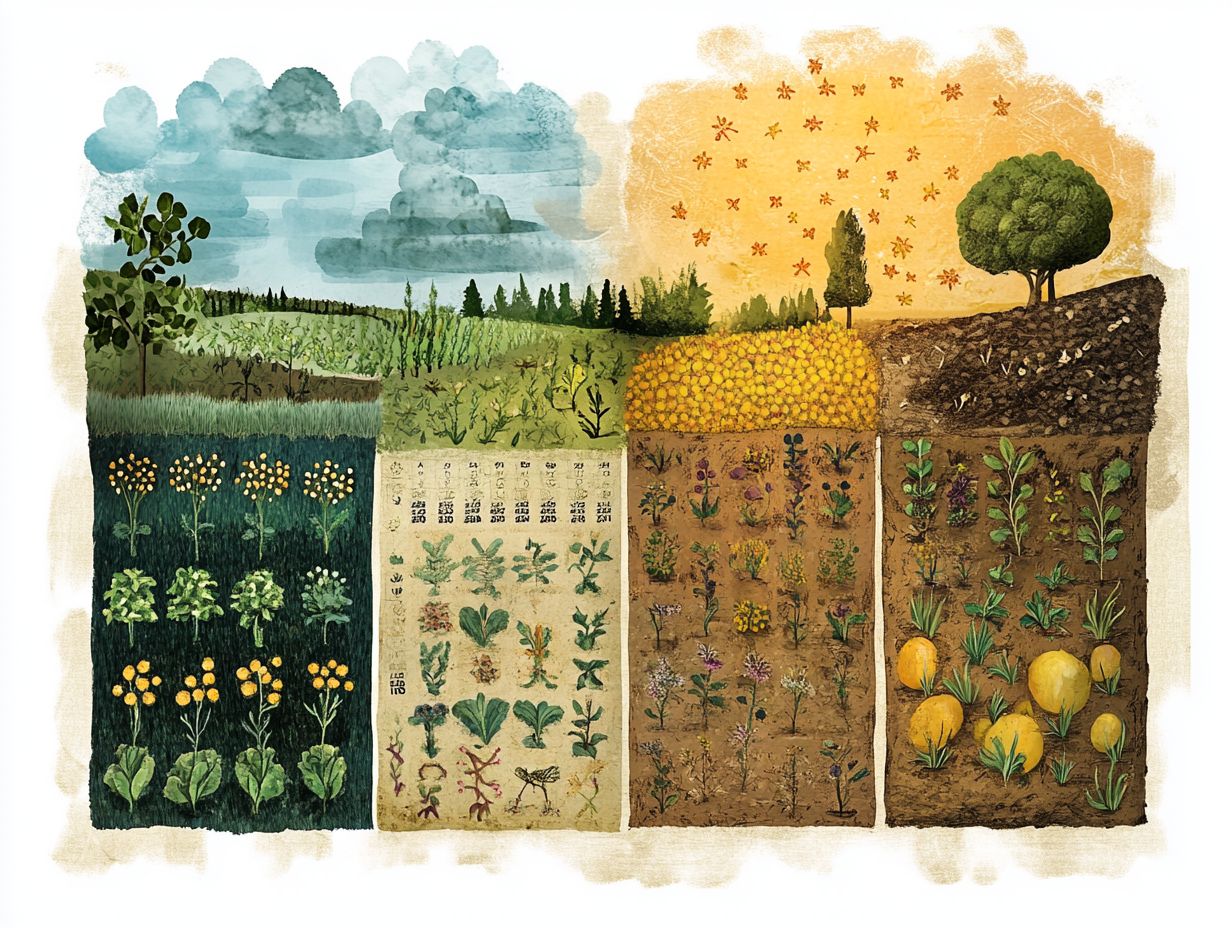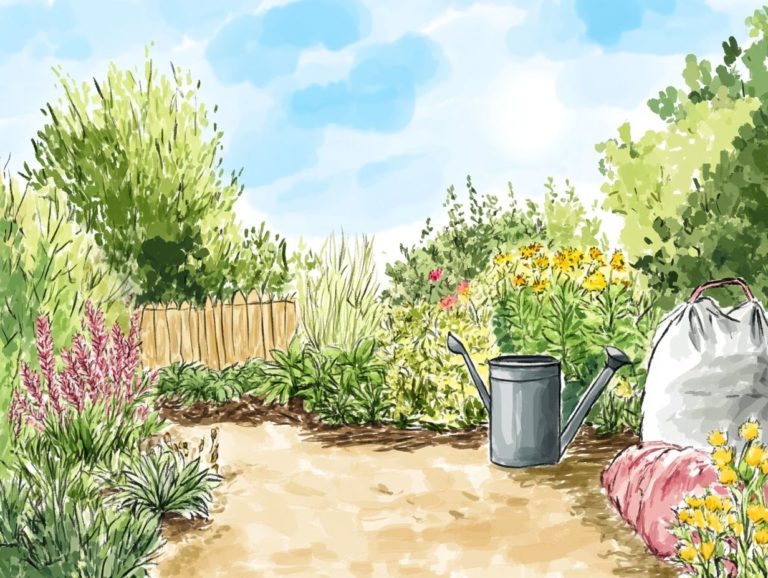Seasonal Fertilization Schedules
Fertilization is essential for successful gardening and landscaping. Many gardeners underestimate the importance of timing, which is crucial for a lush lawn.
Understanding how and when to fertilize your plants can greatly influence their growth, health, and resilience throughout the seasons.
This article covers the essentials of fertilization schedules. It emphasizes the advantages of a seasonal approach and critical factors to consider, including customized schedules for spring, summer, fall, and winter, along with specific fertilizer application rates.
Arm yourself with the knowledge needed to cultivate flourishing plants all year round!
Contents
- Key Takeaways:
- Understanding Fertilization Schedules
- Benefits of Following a Seasonal Schedule
- Factors to Consider for Seasonal Fertilization
- Spring Fertilization Schedule
- Summer Fertilization Schedule
- Fall Fertilization Schedule
- Winter Fertilization Schedule
- Frequently Asked Questions
- What is a seasonal fertilization schedule?
- Why is a seasonal fertilization schedule important?
- How do I create a seasonal fertilization schedule?
- Do all plants require the same fertilization schedule?
- What are the benefits of following a seasonal fertilization schedule?
- Can a seasonal fertilization schedule be adjusted?
Key Takeaways:

- Following a seasonal fertilization schedule maximizes plant growth and health by providing the right nutrients at the right time.
- Factors such as soil composition and plant needs should be considered when creating a seasonal fertilization schedule.
- Each season has its own specific timing and types of fertilizers to use, including special considerations for winter fertilization to prepare plants for the next season.
Understanding Fertilization Schedules
Understanding fertilization schedules is essential for cultivating a vibrant lawn, as it involves the strategic application of nutrients designed to elevate both the health and appearance of your grass throughout the year.
A thoughtfully crafted fertilization schedule takes into account seasonal changes, soil composition, and the specific types of grass in your yard. This ensures that your lawn receives the right nutrients such as nitrogen, phosphate, and potassium precisely when they re needed most.
By sticking to this schedule, you can enjoy robust grass growth, deeper roots, and enhanced resilience against stresses like drought and pests. It’s essential for anyone who wants a beautiful lawn.
What is a Fertilization Schedule?
A fertilization schedule is your strategic blueprint for applying fertilizers to your lawn and garden, ensuring that nutrients are available when your grass needs them most for optimal growth.
By considering seasonal changes and the unique requirements of various grass types, this schedule elevates the vitality of your entire landscape. Timing is everything; in spring, you ll want to focus on nitrogen to promote vigorous green growth, while in the fall, your attention should shift to phosphorus and potassium, which support root health and winter resilience.
Soil temperature is a key player in determining the best application moments; as the warmer months approach, the frequency of feeding increases. Adhering to a well-structured fertilization plan not only enriches your soil but also cultivates a lush, resilient turf that can better endure environmental challenges.
Benefits of Following a Seasonal Schedule
Adhering to a seasonal fertilization schedule offers a wealth of advantages for those passionate about lawn care. By providing your grass with the right nutrients at the optimal times, you pave the way for vigorous growth and increased resilience against environmental stresses.
When you strategically time your applications, you enhance nutrient absorption, leading to healthier roots and lush, green blades. This approach also helps you sidestep issues like too little or too much fertilizer that could detract from your lawn’s appearance.
Focusing on seasonal changes helps you customize your fertilization strategy to meet specific needs think spring feeding to kickstart new growth and fall feeding to prepare your lawn for a restful winter.
Get ready to transform your lawn! Start your fertilization journey today to see the incredible results for yourself!
Maximizing Plant Growth and Health
Maximizing the growth and health of your lawn requires a keen understanding of the unique needs of different grass types. Ensuring they receive the right nutrients during those critical growth periods is essential.
By adopting tailored approaches, you can significantly reduce stress on your lawns, allowing them to thrive even under challenging conditions. For instance, cool-season grasses thrive on high nitrogen fertilizers in early spring, while warm-season varieties may flourish with potassium-rich nutrients during the summer, enhancing their ability to survive dry periods. Additionally, using organic fertilizers like Milorganite can further improve plant health.
Conducting soil tests is invaluable; they help you identify nutrient deficiencies specific to your grass type, laying a solid foundation for informed decisions. Regularly mowing at the correct height encourages deeper root systems, promoting resilience against environmental stressors.
By implementing these strategies, you create an ideal synergy between the grass s genetic makeup and its nutrient intake, fostering a lush, healthy lawn that stands out.
Factors to Consider for Seasonal Fertilization

When you re planning seasonal fertilization, it s essential to consider several factors, such as soil composition, plant needs, and the prevailing environmental conditions. These elements greatly impact the effectiveness of your fertilization efforts, particularly when applying fertilizers at the right times.
Understanding the specific nutrient requirements of different grass types like Kentucky bluegrass, Fescue, or Bermuda allows for a more tailored approach to fertilizing, ensuring optimal health and appearance.
Soil moisture, temperature changes, and other factors are crucial for determining the best times to apply fertilizers and the types of fertilizers to use. This helps your lawn thrive all year.
Soil Composition and Plant Needs
The composition of your soil directly impacts the needs of your plants, as it dictates the availability of essential nutrients necessary for vibrant grass growth and overall health.
This is why soil testing is a critical step for anyone aiming to cultivate specific grass types effectively. Different species of grass come with their own distinct nutrient requirements; for example, fescue thrives in nitrogen-rich soils, while zoysia grasses flourish with a balanced nutrient profile.
By assessing the existing nutrient levels and composition of your soil, you can customize amendments and fertilizers to fulfill the precise needs of your plants. This targeted approach not only promotes healthier grass growth but also enhances resistance against pests and diseases, ultimately leading to a lush and resilient landscape that you can take pride in.
Spring Fertilization Schedule
The spring fertilization schedule is an important part of your lawn care routine, signaling the shift from winter dormancy to vibrant growth. This process typically involves a timely application of nutrients that are specifically tailored to meet your lawn’s needs.
As temperatures rise, your grass will awaken from its slumber, necessitating a well-thought-out fertilization strategy. Incorporating organic options like Milorganite can promote robust root development and lush green blades.
Spring is your chance to assess your lawn and kick-start its growth! Conduct soil tests now and apply fertilizers to supercharge your lawn’s growth!
Timing and Types of Fertilizers
Timing and types of fertilizers are crucial aspects to consider during spring fertilization, as they significantly influence how effectively nutrients are delivered to your grass.
By applying fertilizers at just the right moment, you ensure that your grass receives essential nutrients precisely when it needs them most. This fosters vigorous growth and resilience!
For instance, cool-season grasses, which thrive in spring, flourish with a balanced fertilizer containing equal parts nitrogen, phosphorus, and potassium to support their growth spurt. A broadcast application rate of about 1 pound of nitrogen per 1,000 square feet is often recommended for optimal results.
On the other hand, warm-season grasses typically favor a higher nitrogen content as temperatures rise. Understanding these specifics helps you manage nutrients effectively, optimizing the overall health and appearance of your lawn.
Summer Fertilization Schedule
The summer fertilization schedule is essential for maintaining your lawn’s vitality during the sweltering months! It s important to take a tailored approach that considers moisture levels and the heat stress affecting various grass types.
As temperatures climb, your grass may face stress. It s important to monitor soil moisture and nutrient requirements closely to promote ongoing growth and resilience.
Employing methods like deep watering and using slow-release fertilizers can alleviate the stress your lawn endures during this season, paving the way for robust growth and a vibrant, lush appearance.
Adjusting for Hot Weather and Plant Growth
Adjusting for the sweltering summer heat is vital for optimizing your plant growth! This ensures your grass receives the nutrients it needs while managing the stress that high temperatures bring.
To accomplish this, implement strategies that prioritize moisture management and the precise application of fertilizers. A highly effective method is to water deeply and infrequently, allowing the roots to grow stronger by reaching down for moisture in the deeper soil layers.
Timing is key; applying nutrients in the early morning or late afternoon helps prevent evaporation and enhances absorption. Consider using slow-release fertilizers these provide a steady supply of nutrients without overwhelming your plants.
By taking these thoughtful steps, you empower your lawn to withstand the summer heat while promoting vibrant, healthy growth!

Fall Fertilization Schedule
The fall fertilization schedule is crucial for preparing your lawn for the winter months and ensuring it thrives in the upcoming season. Focusing on applying essential nutrients significantly enhances your plants’ health!
As temperatures cool, grass types such as Zoysia, Fescue, and Bermuda truly benefit from a well-timed fertilization strategy. This approach supercharges root development and bolsters resilience against winter stresses!
Adopting a fall fertilization plan positions your lawn for success, paving the way for a lush and vibrant landscape come springtime.
Preparing Plants for Winter and Next Season
Preparing your plants for winter involves applying the right nutrients to build resilience and health in various grass types. This way, they can brave the cold and emerge strong for the next season!
Also, proper fertilization is crucial. Adjust your watering practices too. Providing adequate moisture before the ground freezes helps the roots establish well.
It s wise to mow the grass slightly shorter before winter sets in, allowing sunlight to penetrate the foliage and preventing snow mold.
Applying a winterizing fertilizer rich in potassium boosts stress tolerance and encourages deeper root growth. With these specific preparations, your grass types will thrive during dormancy, and you ll witness a vigorous green resurgence in the spring, ready to tackle any challenges!
Winter Fertilization Schedule
The winter fertilization schedule might not be top of mind, but it plays a crucial role in delivering essential nutrients during your grass’s dormant phase. This practice boosts your lawn’s health dramatically, setting the stage for a thriving growing season ahead.
Even if your lawn seems inactive, adding targeted nutrients during this dormant period can greatly enhance the soil s organic matter and encourage a robust resurgence come spring. By embracing a winter fertilization strategy, you can ensure your lawn is well-equipped to tackle the challenges of the colder months.
Key Tips for Effective Winter Fertilization
When considering winter fertilization, you need to assess various factors to ensure that adding nutrients is effective and tailored to the specific needs of different grass types. Understanding the distinct requirements of cool-season versus warm-season grasses is essential for achieving optimal growth and resilience.
Soil testing is vital in this process. It allows you to assess nutrient levels and pH balance accurately. This information significantly influences how effective your fertilizers will be during the colder months. By taking into account local climate conditions and potential winter stressors, you can make informed decisions that promote healthy turf.
By addressing these elements, you’ll maximize the benefits of winter fertilization, ensuring that your grass types are primed to thrive come spring.
Frequently Asked Questions

What is a seasonal fertilization schedule?
A seasonal fertilization schedule is a planned timeline for when and how to fertilize different types of plants based on their specific needs throughout the year.
Why is a seasonal fertilization schedule important?
A seasonal fertilization schedule is crucial because it ensures that plants receive the necessary nutrients at the right time, promoting healthy growth and preventing nutrient deficiencies or excesses.
How do I create a seasonal fertilization schedule?
To create a seasonal fertilization schedule, research the nutrient needs of the plants in your garden and determine which type of fertilizer is best for them. Then, based on the specific recommendations for each plant, create a timeline for when to fertilize.
Do all plants require the same fertilization schedule?
No, different plants have different nutrient needs and may require fertilization at different times. It’s important to research the specific needs of each plant and adjust the fertilization schedule accordingly.
What are the benefits of following a seasonal fertilization schedule?
Following a seasonal fertilization schedule can promote stronger and healthier plants, increase yield, and improve the overall appearance of your garden. It can also save time and money by preventing over-fertilization or under-fertilization.
Can a seasonal fertilization schedule be adjusted?
Yes, a seasonal fertilization schedule can be adjusted if needed. Factors such as weather, plant health, and soil conditions may require changes to the original schedule. It’s important to regularly monitor plants and make adjustments as necessary.
Start planning your winter fertilization today for a flourishing spring!






